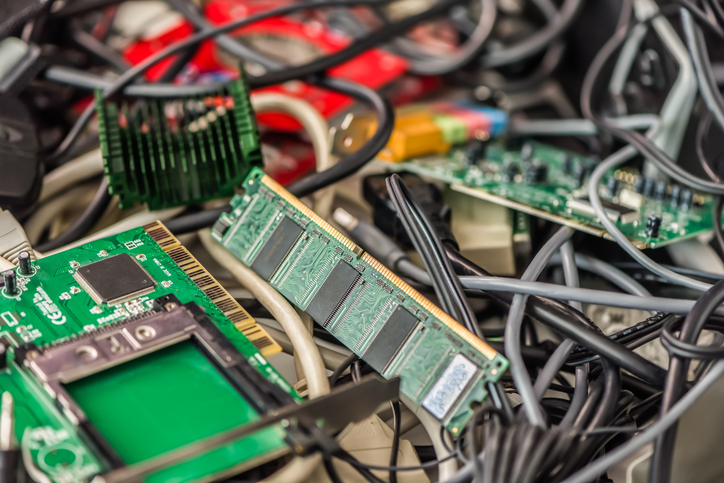How long does a computer or printer tend to last at your business before it needs to be replaced? When you start thinking about all the electronics that your business disposes of in an average year, it’s easy to understand why electronics recycling is such a massive and urgent challenge. We’re producing record amounts of electronic waste every year, but estimates say that less than 20% of the world’s e-waste actually gets recycled. Everyone needs to know how to recycle electronics correctly, especially business leaders who are responsible for a lot of devices. (The good news–It’s pretty straightforward!)
How to Recycle Electronics Responsibly
Step 1: Review any relevant recycling laws and assess whether any of your electronics are hazardous.
Many electronics are made with components that could be toxic if someone was exposed to them, like LCD monitors that contain mercury. That’s why some places have laws requiring certain electronics to be recycled in particular ways. The devices themselves are perfectly safe to touch and use, but could become dangerous to recycling workers if they break.
It’s always advisable to stay current with any general recycling laws or waste bans that are relevant in your state and municipality. Some states allow individuals and businesses to dispose of electronics in landfills, while others have strict e-waste disposal laws on the books. Here in Massachusetts, law requires that old cathode-ray tube monitors and anything made with mercury are treated as hazardous waste. MassDEP is a good resource for finding collection locations that accept these materials.
Step 2: Assess the data-storing abilities of any electronics you’re getting rid of.
This step is only relevant if your business is getting rid of things that still work and you’re interested in donating or selling them. Best practice is for your data security policy to include language requiring all obsolete electronics to be recycled, unless they’re incapable of storing sensitive data. Any of your company’s electronics that have a memory/hard drive should be destroyed when you’re done with them. But, things like keyboards, computer monitors and DVD players might be donated or sold to new owners without creating a data security risk.
If no one on your team has the time or inclination to post your items on a platform like Facebook Marketplace, or find a charity that could use the specific items you have, these things can always be recycled along with the rest of your electronics.
Step 3: Verify that any important data is removed from electronics (but don’t try to disassemble them).
In other words, make sure you don’t accidentally get rid of a hard drive that contains the only record of an important document. Check and double-check that you’ve made copies of any data stored on your obsolete electronics. You can follow the manufacturer’s directions to wipe or overwrite the data as an extra security measure. There’s no need to disassemble your own devices before recycling them.
Step 4: Partner with a reputable local recycling service that accepts electronics.
Recyclers like Miller Recycling aren’t necessarily equipped to actually process every kind of material that comes in, but we do know what to do with everything that we collect. Recyclers like us sort a huge quantity of mixed waste every day. Some of it can’t be recycled or reused and gets diverted to landfills. Other materials, like paper and scrap metal, may be shredded on-site and sold to manufacturers. Electronics can be more complicated because they need to be disassembled and may need to go through multiple sorting processes to fully separate all the individual components. Hard drives must also be removed so they can be securely destroyed through shredding. (If you’re curious about exactly what your recycling provider will do with your electronics, feel free to ask!)
How NOT to Recycle Electronics: 3 Things to Avoid
1: Taking them to manufacturer take-back programs or community electronics recycling events (with some exceptions). Take-back programs run by retailers and manufacturers are usually only open to individuals, not businesses. The same is typically true of community e-waste recycling events. If you own a small business that has a few obsolete electronics to recycle, you may be able to turn them in to the manufacturer or a store like Best Buy as an individual. But these programs aren’t a viable solution for most businesses that generate a lot of e-waste.
2: Leaving them unsecured for any period of time. The longer a broken laptop or dead phone sits in a storage room, the greater the chance becomes that an employee or visitor will think it won’t be missed, and grab it to take home. Keep obsolete electronics locked up until your recycling company can come pick them up.
3: Failing to keep complete records about electronics disposal. It’s unlikely but not impossible that some day you’ll need to prove you recycle your e-waste responsibly. Let’s say your data disposal procedures ever come up in an audit, or a client suffers a data leak and you need to provide evidence that you properly destroyed any digital files you had on them. Keep logs of all your data disposal activities, including serial numbers of any electronics that you have destroyed.
We Know How to Recycle Electronics Responsibly—Just Ask!
Miller Recycling has been helping customers manage their electronic waste for decades. We stay current on all e-waste recycling best practices so our customers don’t have to. If you have any questions about how to recycle electronics, or other questions about creating more efficient recycling systems for your business, I’m happy to help. Contact me today!


